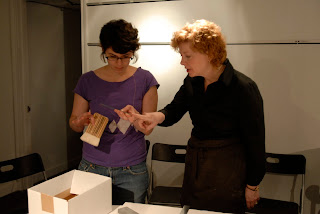Sunday, May 4, 2008
Scully and Osterman
These photos are woefully out of order. But essentially, we learned how to make ambrotypes. That's Jenni under the watchful eye of France Scully Osterman. She's pouring collodion on a plate. After that, it will be dunked in a bucket of silver nitrate to make it light sensitive, then put in a plate holder and a photo will be taken. The guy in the foreground is Mark Osterman, France's husband, who teaches at George Eastman House. He thinks polishing the plate is important, too.


Rachel decided that it wasn't a good thing to take photos at 1000 ISO without any humor. The darkroom was pretty dark, so I cranked up the sensitivity and cranked down the aperture. But it is kind of cool to see France Scully doing what she does pretty well.


Mark Osterman (the other half of Scully and Osterman) is warming the varnish (one of the last steps).

the developer. You can't buy it. You have to get a formula and order the chemicals. France did this the day before the workshop. By the way, their work is on display at the Houston Center for Photography (http://www.hcponline.org/.) and it is quite good.


The varnishing stage. Essentially, you take a plate, cover it with flammable material, and expose it to an open flame. Again, well out of order. This is the last step. After fixing the varnish by exposing it to a flame, you can either put the plate in an airtight container (as was typical in the 19th century) or park it on a bookshelf. After a few weeks you can touch it.


Out of order again, here's the development stage. And the homemade box that you need to hold either the silver nitrate (for sensitivity) or arsenic (f0r fixing). The boxes are identical. The footstool was used to hold distilled water used to slow the development process. Once you see tonality in the face, you throw water into the tray.




Rachel decided that it wasn't a good thing to take photos at 1000 ISO without any humor. The darkroom was pretty dark, so I cranked up the sensitivity and cranked down the aperture. But it is kind of cool to see France Scully doing what she does pretty well.


Mark Osterman (the other half of Scully and Osterman) is warming the varnish (one of the last steps).

the developer. You can't buy it. You have to get a formula and order the chemicals. France did this the day before the workshop. By the way, their work is on display at the Houston Center for Photography (http://www.hcponline.org/.) and it is quite good.
High-tech equipment. Diligent student. That's Jenni polishing her plate. The foil was used to make a reflector. The collodion process isn't ISO 1000 by a long shot. They had to fabricate a reflector, much like they fabricate everything else.


The varnishing stage. Essentially, you take a plate, cover it with flammable material, and expose it to an open flame. Again, well out of order. This is the last step. After fixing the varnish by exposing it to a flame, you can either put the plate in an airtight container (as was typical in the 19th century) or park it on a bookshelf. After a few weeks you can touch it.


Mark Osterman tells us how to varnish the plates. Ironically, and despite what this photo suggests, one should not look up or the plate will catch on fire.
Out of order again, here's the development stage. And the homemade box that you need to hold either the silver nitrate (for sensitivity) or arsenic (f0r fixing). The boxes are identical. The footstool was used to hold distilled water used to slow the development process. Once you see tonality in the face, you throw water into the tray.


A 19th century wet plate collodion camera.
Labels:
ambrotype,
HCP,
photography,
scully and osterman,
workshop
Subscribe to:
Post Comments (Atom)













No comments:
Post a Comment